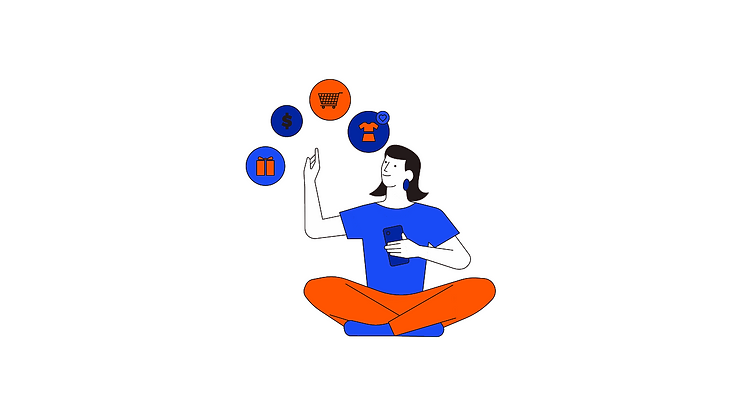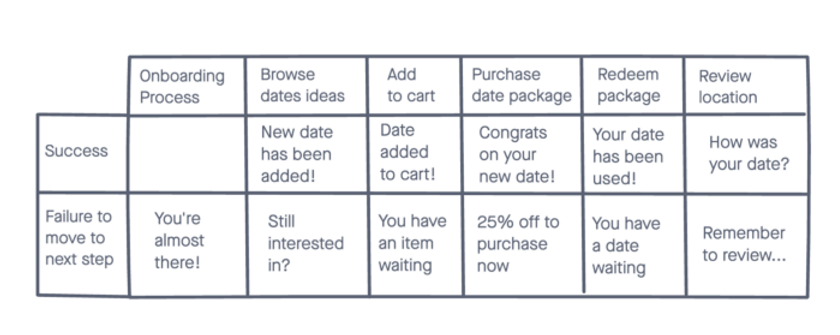6 Steps To A Push Notification Strategy Your Users Will Love


Bruce Peck
Mar 10, 2022 · 10 min readWhy create a push notification strategy?
So your app is live (and if that’s not true check out this article), but you’re trying to increase
how often people use the app. Push notifications are a powerful tool to re-engage your users and bring value to them, yet they are often underestimated and underutilized.
When done right they can dramatically increase your user engagement, when done wrong they can annoy the heck out of your users. In this article, we will discuss how to systematically send push notifications that are timely, valuable and that will enhance both your user's life and your bottom line.
The Power of Push Notifications: A Case Study
Let me tell you a story: I used to run an app called Doorstep, we made it easy for people to find cool things to do for date night. We discovered that many of our users weren’t aware of the new date packages that were added to our app.
So we gathered the board of the company and discussed what we could do.
After discussing the issue for about an hour, l somebody asked the golden question, “How many notifications are we sending a week?” To which I responded, feebly, “One.” “What would happen if we sent a notification every day?” they asked.
The answer? User activity more than doubled and our sales increased dramatically. Did we receive tons of complaints about the increase in notifications? No. In fact, we were complimented by many by how helpful we were.
How could that be? The reason is that people are only annoyed by notifications when they are not relevant to them. For example, have you ever gotten annoyed that your text messaging application pings you 30 or 40 times a day? No? Why not? Because every time you get a text it is relevant and important to your life.
What makes a good push notification?
BJ Foggs, a behavior analyst, has a theory that can be used to explain why a user responds to a push notification. He says, “B=MAP, Behavior (B) happens when Motivation (M), Ability (A), and a Prompt (P) come together at the same moment.”
Let’s give a practical example of this, you get a push notification that says, “Jane Warren wants to be friends.” It just so happens that Jane is one of your best friends from high school that you haven’t seen in ages, so your motivation (M) is high, and your ability (A) is also really high, so you tap the notification.
On the opposite end of the spectrum, imagine you get a push notification that says, “50% off whole milk” and you are lactose intolerant. Your motivation (M) is low, even though your ability (A) is high, so you are unlikely to click, and if the notification appears frequently you are likely to get annoyed.
The goal is to find where the motivation, ability, and a good prompt can intersect such that the behavior it produces is beneficial for the user and your business.
How to build a push notification strategy:
Step 1: Break up your users into groups
Every app has different users that have different motives. Sometimes those user groups are defined by the business model such as free vs paid, buyer vs seller, client vs professional. And other times it is defined by the behavior of the users, power seller vs. occasional seller, etc.
To begin creating a push notification strategy it is important to list out all the different user groups that you want to create push notifications for. As time goes on you can add to this list as new cohorts of users emerge.
Step 2: Map out each user groups flow through the app
Next, it may be good to head over to a whiteboard. You’ll want to list horizontally all the steps that an ideal user of that group would take through the app. Then underneath those draw-out sections for failure and success.
It may help to frame the user journey in the stages that are suggested by the “Pirate Metrics” namely:
- Activation: What does it take for this user to sign up?
- Revenue: What steps does the user need to take in order to begin producing revenue for the company?
- Retention: What things does the user need to do to continue to get value from the app?
- Referral: What needs to happen before the user will be excited to share the app with their friends? When can we prompt them to rate/review the app so they are most likely to do it?
When you’re done it should look something like this:

Step 3: Decide where to put push notifications
The next step is to decide which kinds of push notifications to send, and when to send them. Here is a list of common types of notifications (as suggested by phiture):
1. Operational: A functional receipt for an action performed in the app, such as payment confirmation or a password reset.
2. Activity: Push notifications trigger by other users or external events, such as new content published, a friend notification, new messages.
3. Cron Jobs: Push notifications triggered on a regular basis due to scheduled events. Such as a deal of the week or reminders to log an event.
4. Drip Campaigns: Sending push notifications or emails on a predetermined schedule to educate and onboard users.

Step 4: Define your hypothesis for each notification
Now that you have a list of potential push notifications, it’s time to write out how you think the push notification is going to perform.
The reason why we do this is in order to be able to determine if the push notification is helping to accomplish our business goals or if it is failing to live up to the expectations we have for it.
Here’s how a possible hypothesis may be written, “if we send a push notification immediately after each time a user’s friend comments on their photo we expect to be able to send an additional 10,000 push notifications with a 10% open rate resulting in a 3% uptick in daily active users”
Step 5: Run your experiment
Once you have written a clear hypothesis for all of your push notifications then it is time to implement them in your code.
If you are using cool tools like mixpanel you can create the notifications for your user groups, track the effectiveness of the notification, etc. all in the same place, otherwise, you’ll need a programmer to set it up.
If you have an active user base that is large enough (to give you statistical significance) it is best to have a control group and a test group. This allows you to see if the push notification makes an actual difference.
Give the experiment time to run so that you can clearly see what happens.
Step 6: Analyze performance, adjust and repeat
Once your test has reached enough users to reach statistical significance or if you have too small of a user base a certain amount of time has elapsed, it is time to go back and look through the data.
Some helpful questions to ask are:
- How did the control group and the test group perform?
- How did the users with this push notification perform differently than the control group?
- Did the push notification achieve the results we were looking for? Why or why not?
- Is there any anecdotal evidence that may help us to understand why the notification performed the way it did?
- Are there any new opportunities for push notifications we discovered?
This allows you to adjust the push notifications to make them more relevant, and help you see places where you can improve your notification strategy in the future.
There you have it, that’s how you create your first push notification strategy. If you’d like help figuring it out for your own app, schedule a meeting with us!